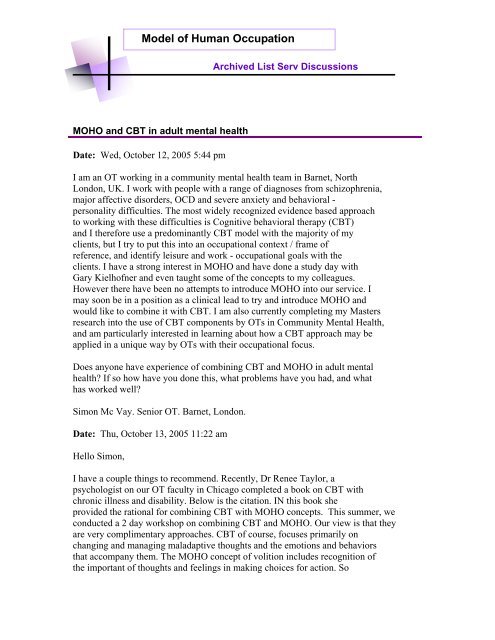MOHO and CBT in adult mental health
MOHO and CBT in adult mental health
MOHO and CBT in adult mental health
- No tags were found...
You also want an ePaper? Increase the reach of your titles
YUMPU automatically turns print PDFs into web optimized ePapers that Google loves.
Model of Human OccupationArchived List Serv Discussions<strong>MOHO</strong> <strong>and</strong> <strong>CBT</strong> <strong>in</strong> <strong>adult</strong> <strong>mental</strong> <strong>health</strong>Date: Wed, October 12, 2005 5:44 pmI am an OT work<strong>in</strong>g <strong>in</strong> a community <strong>mental</strong> <strong>health</strong> team <strong>in</strong> Barnet, NorthLondon, UK. I work with people with a range of diagnoses from schizophrenia,major affective disorders, OCD <strong>and</strong> severe anxiety <strong>and</strong> behavioral -personality difficulties. The most widely recognized evidence based approachto work<strong>in</strong>g with these difficulties is Cognitive behavioral therapy (<strong>CBT</strong>)<strong>and</strong> I therefore use a predom<strong>in</strong>antly <strong>CBT</strong> model with the majority of myclients, but I try to put this <strong>in</strong>to an occupational context / frame ofreference, <strong>and</strong> identify leisure <strong>and</strong> work - occupational goals with theclients. I have a strong <strong>in</strong>terest <strong>in</strong> <strong>MOHO</strong> <strong>and</strong> have done a study day withGary Kielhofner <strong>and</strong> even taught some of the concepts to my colleagues.However there have been no attempts to <strong>in</strong>troduce <strong>MOHO</strong> <strong>in</strong>to our service. Imay soon be <strong>in</strong> a position as a cl<strong>in</strong>ical lead to try <strong>and</strong> <strong>in</strong>troduce <strong>MOHO</strong> <strong>and</strong>would like to comb<strong>in</strong>e it with <strong>CBT</strong>. I am also currently complet<strong>in</strong>g my Mastersresearch <strong>in</strong>to the use of <strong>CBT</strong> components by OTs <strong>in</strong> Community Mental Health,<strong>and</strong> am particularly <strong>in</strong>terested <strong>in</strong> learn<strong>in</strong>g about how a <strong>CBT</strong> approach may beapplied <strong>in</strong> a unique way by OTs with their occupational focus.Does anyone have experience of comb<strong>in</strong><strong>in</strong>g <strong>CBT</strong> <strong>and</strong> <strong>MOHO</strong> <strong>in</strong> <strong>adult</strong> <strong>mental</strong><strong>health</strong>? If so how have you done this, what problems have you had, <strong>and</strong> whathas worked well?Simon Mc Vay. Senior OT. Barnet, London.Date: Thu, October 13, 2005 11:22 amHello Simon,I have a couple th<strong>in</strong>gs to recommend. Recently, Dr Renee Taylor, apsychologist on our OT faculty <strong>in</strong> Chicago completed a book on <strong>CBT</strong> withchronic illness <strong>and</strong> disability. Below is the citation. IN this book sheprovided the rational for comb<strong>in</strong><strong>in</strong>g <strong>CBT</strong> with <strong>MOHO</strong> concepts. This summer, weconducted a 2 day workshop on comb<strong>in</strong><strong>in</strong>g <strong>CBT</strong> <strong>and</strong> <strong>MOHO</strong>. Our view is that theyare very complimentary approaches. <strong>CBT</strong> of course, focuses primarily onchang<strong>in</strong>g <strong>and</strong> manag<strong>in</strong>g maladaptive thoughts <strong>and</strong> the emotions <strong>and</strong> behaviorsthat accompany them. The <strong>MOHO</strong> concept of volition <strong>in</strong>cludes recognition ofthe important of thoughts <strong>and</strong> feel<strong>in</strong>gs <strong>in</strong> mak<strong>in</strong>g choices for action. So
there is an obvious conceptual connection. Anyhow the resource I recommendto start with isTaylor, R.R. (2005). Cognitive Behavioral Therapy for Individuals withChronic Illness <strong>and</strong> Disability. New York: Spr<strong>in</strong>ger.Good luck with your effortsGary KielhofnerDate: Thu, October 13, 2005 5:47 pmHi Simon,As well as be<strong>in</strong>g an occupational therapist, I am also a qualified cognitivebehaviour therapist. I have <strong>in</strong>corporated <strong>CBT</strong> <strong>and</strong> <strong>MOHO</strong> for several years (<strong>in</strong>a forensic <strong>mental</strong> heath sett<strong>in</strong>g) <strong>and</strong> found them to be em<strong>in</strong>ently compatible.One of the difficulties (as I see it) with <strong>CBT</strong> <strong>in</strong> OT, is that too many OTshave used it "straight" <strong>and</strong> become (<strong>in</strong> practice) CB therapists, notoccupational therapists. This has drawn a lot of criticism from with<strong>in</strong> theprofession. However, this need not be the case.You might f<strong>in</strong>d the follow<strong>in</strong>g chapter (below) useful. Whilst it onlybriefly mentions <strong>MOHO</strong>, there is a focus on <strong>in</strong>tegrat<strong>in</strong>g the cognitivebehavioral approach <strong>in</strong>to occupational therapy <strong>and</strong> highlights therelationship between cognitive behavioural approaches <strong>and</strong> conceptual modelsof practice such as <strong>MOHO</strong>.Ref:Duncan EAS (2005) The cognitive behavioural frame of reference: In EASDuncan (Ed) Foundations for Practice <strong>in</strong> Occupational Therapy (4th Ed).Elsevier/Churchill Liv<strong>in</strong>gstone, Ed<strong>in</strong>burghBest wishesEddie DuncanDate: Tue, October 18, 2005 1:48 pmDear Simon <strong>and</strong> all the listI am an Israeli OT work<strong>in</strong>g <strong>in</strong> a community <strong>mental</strong> <strong>health</strong> center <strong>in</strong> Tel Aviv<strong>and</strong> <strong>in</strong> apsycho geriatric unit. We use for several years the <strong>CBT</strong> <strong>in</strong> comb<strong>in</strong>ation withOT conceptual models, merely with the <strong>MOHO</strong>. We felt almost <strong>in</strong>tuitively thetwo models are most compatible .We apply them <strong>in</strong> <strong>in</strong>dividual <strong>and</strong> <strong>in</strong>
group <strong>in</strong>terventions. It helps are also to expla<strong>in</strong> our profession to theother <strong>mental</strong> <strong>health</strong>team <strong>and</strong> clients' as we focus on volition , occupational identity, choice ofactivities <strong>and</strong> occupations etc.. .Last summer we were lucky <strong>and</strong> had a wonderful workshop with Prof.Kielhofner <strong>and</strong> Dr. Taylor which focused on <strong>in</strong>terweav<strong>in</strong>g the two models. Dueto well organized <strong>and</strong> rich theoretical <strong>and</strong> practical materials, <strong>in</strong>clud<strong>in</strong>gmany case examples <strong>and</strong> open discussions on important issues we got a wide ,<strong>in</strong>-depth <strong>and</strong> sharpened underst<strong>and</strong><strong>in</strong>g .It contributed also to our selfprofessional confidence.Good luck <strong>in</strong> your new job,Noga.Noga Ziv, MSc.OTDepartment of Occupational TherapyStanely Steyer school of <strong>health</strong> professionsSackler faculty of medic<strong>in</strong>eTel Aviv UniversityDate: Wed, October 19, 2005 12:09 pmDear Simon <strong>and</strong> all,My name is René. I'm OT from Canada <strong>and</strong> your questions about the<strong>in</strong>tegration of <strong>MOHO</strong> <strong>and</strong> <strong>CBT</strong> approaches fit exactly with my cl<strong>in</strong>ical<strong>in</strong>vestments for more than 8 years now. I'm work<strong>in</strong>g <strong>in</strong> a specialized programfor young psychotic patients experienc<strong>in</strong>g early <strong>in</strong>tervention for firstpsychosis. For these patients, I have adapted a specialized cognitiveprogram of therapy called : IPT program, Quebec adapted version. Many yearsago, Gary Kielhofner helped me to <strong>in</strong>tegrate <strong>MOHO</strong> tools with this program<strong>and</strong> I must say s<strong>in</strong>ce that time. I have the best cl<strong>in</strong>ical tools to helpsthese young psychotics patients. At that time, I decided to <strong>in</strong>tegrate <strong>MOHO</strong><strong>in</strong>itial assessments (OPHI-II, ACIS <strong>and</strong> VQ) <strong>and</strong> to <strong>in</strong>tegrate the model <strong>in</strong>tothe process of therapy application with the mix of IPT program. Mymultidiscipl<strong>in</strong>ary team needs first, a tra<strong>in</strong><strong>in</strong>g but now they don't wantanyth<strong>in</strong>g else. They adopt <strong>MOHO</strong> vocabulary <strong>and</strong> they like it very much . Ifyou want more details about this cognitive behavioral program <strong>and</strong> <strong>MOHO</strong>application, you will f<strong>in</strong>d it <strong>in</strong> the last Gary's publication. Here you havespecific reference: Kielhofner, G. (2002). Model of Human Occupation (thirdEdition), Philadelphia: Lipp<strong>in</strong>cott Williams & Wilk<strong>in</strong>s, chapter 26, pages508 à 516.I also did tree years ago a paper <strong>in</strong> English for Gary Kielhofner's students
<strong>and</strong> if you are <strong>in</strong>terested, I can send you this paper.Moreover if you can read French text. I've just f<strong>in</strong>ished to write a chapter<strong>in</strong> French about specific applications of <strong>MOHO</strong> with <strong>mental</strong> <strong>health</strong> patients.In this chapter, you will f<strong>in</strong>d a long <strong>and</strong> very detailed patient case,where I used <strong>MOHO</strong>ST, ACIS, OPHI - II assessments <strong>and</strong> I expla<strong>in</strong> <strong>in</strong> this casewith details the <strong>in</strong>tegration of <strong>MOHO</strong> <strong>and</strong> cognitive-behavioral IPT programfor the application of therapy (goals <strong>and</strong> detailed process of therapy).This book will be publish soon <strong>in</strong> French European country <strong>and</strong> Canada. Ifit's possible for you to read French, contact me directly.I hope these <strong>in</strong>formation’s will help you to realize what you are expect<strong>in</strong>g.You will be very happy about results, for your patients <strong>and</strong> for you <strong>and</strong>your cl<strong>in</strong>ical team.Don't hesitate to contact me for more detailsBest regards <strong>and</strong> excuse my poor English language.René Bélanger, Ergothérapeute. MBAProfesseur de cl<strong>in</strong>ique, Université LavalHôtel-Dieu de Lévis143, Rue WolfeLévis QcCanada G6V 3Z1
















